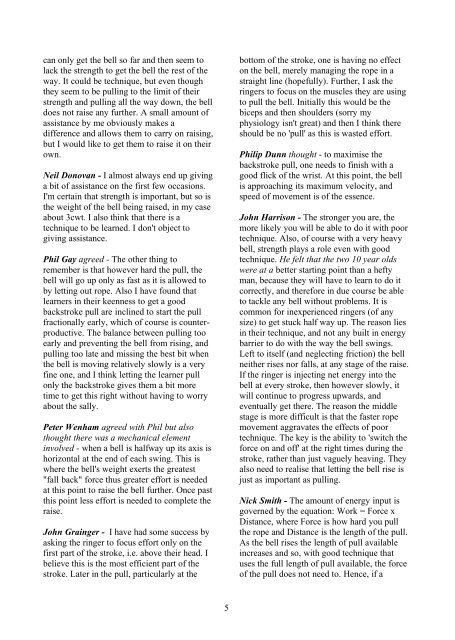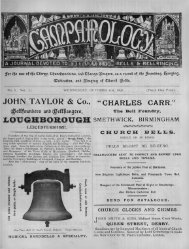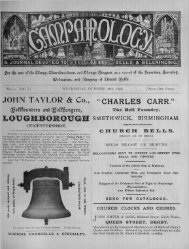The Central Council of Church Bell Ringers Education Committee
The Central Council of Church Bell Ringers Education Committee
The Central Council of Church Bell Ringers Education Committee
You also want an ePaper? Increase the reach of your titles
YUMPU automatically turns print PDFs into web optimized ePapers that Google loves.
can only get the bell so far and then seem to<br />
lack the strength to get the bell the rest <strong>of</strong> the<br />
way. It could be technique, but even though<br />
they seem to be pulling to the limit <strong>of</strong> their<br />
strength and pulling all the way down, the bell<br />
does not raise any further. A small amount <strong>of</strong><br />
assistance by me obviously makes a<br />
difference and allows them to carry on raising,<br />
but I would like to get them to raise it on their<br />
own.<br />
Neil Donovan - I almost always end up giving<br />
a bit <strong>of</strong> assistance on the first few occasions.<br />
I'm certain that strength is important, but so is<br />
the weight <strong>of</strong> the bell being raised, in my case<br />
about 3cwt. I also think that there is a<br />
technique to be learned. I don't object to<br />
giving assistance.<br />
Phil Gay agreed - <strong>The</strong> other thing to<br />
remember is that however hard the pull, the<br />
bell will go up only as fast as it is allowed to<br />
by letting out rope. Also I have found that<br />
learners in their keenness to get a good<br />
backstroke pull are inclined to start the pull<br />
fractionally early, which <strong>of</strong> course is counterproductive.<br />
<strong>The</strong> balance between pulling too<br />
early and preventing the bell from rising, and<br />
pulling too late and missing the best bit when<br />
the bell is moving relatively slowly is a very<br />
fine one, and I think letting the learner pull<br />
only the backstroke gives them a bit more<br />
time to get this right without having to worry<br />
about the sally.<br />
Peter Wenham agreed with Phil but also<br />
thought there was a mechanical element<br />
involved - when a bell is halfway up its axis is<br />
horizontal at the end <strong>of</strong> each swing. This is<br />
where the bell's weight exerts the greatest<br />
"fall back" force thus greater effort is needed<br />
at this point to raise the bell further. Once past<br />
this point less effort is needed to complete the<br />
raise.<br />
John Grainger - I have had some success by<br />
asking the ringer to focus effort only on the<br />
first part <strong>of</strong> the stroke, i.e. above their head. I<br />
believe this is the most efficient part <strong>of</strong> the<br />
stroke. Later in the pull, particularly at the<br />
5<br />
bottom <strong>of</strong> the stroke, one is having no effect<br />
on the bell, merely managing the rope in a<br />
straight line (hopefully). Further, I ask the<br />
ringers to focus on the muscles they are using<br />
to pull the bell. Initially this would be the<br />
biceps and then shoulders (sorry my<br />
physiology isn't great) and then I think there<br />
should be no 'pull' as this is wasted effort.<br />
Philip Dunn thought - to maximise the<br />
backstroke pull, one needs to finish with a<br />
good flick <strong>of</strong> the wrist. At this point, the bell<br />
is approaching its maximum velocity, and<br />
speed <strong>of</strong> movement is <strong>of</strong> the essence.<br />
John Harrison - <strong>The</strong> stronger you are, the<br />
more likely you will be able to do it with poor<br />
technique. Also, <strong>of</strong> course with a very heavy<br />
bell, strength plays a role even with good<br />
technique. He felt that the two 10 year olds<br />
were at a better starting point than a hefty<br />
man, because they will have to learn to do it<br />
correctly, and therefore in due course be able<br />
to tackle any bell without problems. It is<br />
common for inexperienced ringers (<strong>of</strong> any<br />
size) to get stuck half way up. <strong>The</strong> reason lies<br />
in their technique, and not any built in energy<br />
barrier to do with the way the bell swings.<br />
Left to itself (and neglecting friction) the bell<br />
neither rises nor falls, at any stage <strong>of</strong> the raise.<br />
If the ringer is injecting net energy into the<br />
bell at every stroke, then however slowly, it<br />
will continue to progress upwards, and<br />
eventually get there. <strong>The</strong> reason the middle<br />
stage is more difficult is that the faster rope<br />
movement aggravates the effects <strong>of</strong> poor<br />
technique. <strong>The</strong> key is the ability to 'switch the<br />
force on and <strong>of</strong>f' at the right times during the<br />
stroke, rather than just vaguely heaving. <strong>The</strong>y<br />
also need to realise that letting the bell rise is<br />
just as important as pulling.<br />
Nick Smith - <strong>The</strong> amount <strong>of</strong> energy input is<br />
governed by the equation: Work = Force x<br />
Distance, where Force is how hard you pull<br />
the rope and Distance is the length <strong>of</strong> the pull.<br />
As the bell rises the length <strong>of</strong> pull available<br />
increases and so, with good technique that<br />
uses the full length <strong>of</strong> pull available, the force<br />
<strong>of</strong> the pull does not need to. Hence, if a









